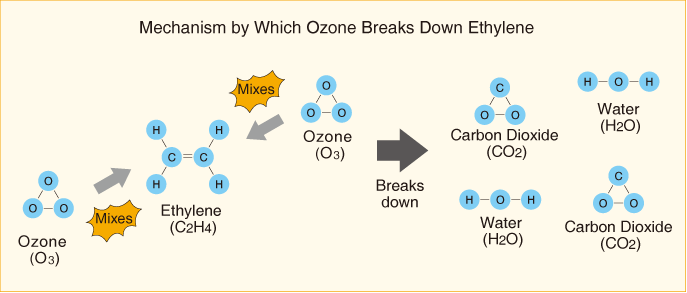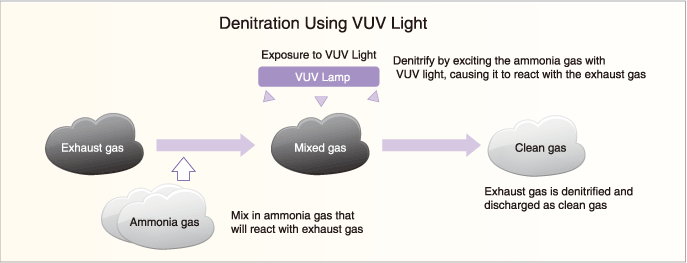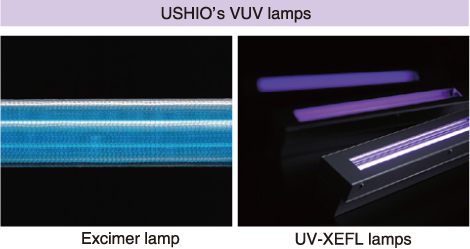Have you heard of vacuum ultraviolet (VUV) radiation? It is found in sunlight, but as it travels through air it is absorbed by oxygen, so it doesn’t reach the surface of the Earth. It was given its name because it can exist only in a vacuum. Of all types of light, VUV has the shortest wavelength, packing the greatest punch in terms of energy. It is known that it can trigger a variety of photochemical and biological reactions and it is used in a wide range of contexts, including semiconductor manufacturing and photo-cleaning of LCD panels. Now, it is attracting attention as one way of tackling issues of global concern, including those relating to the environment, agriculture, and energy.
Invisible Light Makes Plants Grow?
Light plays a major role in the growth of plants, and its benefits differ according to the wavelength: Infrared light has the greatest effect on photosynthesis, while UV light is believed to be necessary for normal development of leaf shape. Recent research demonstrated that UV radiation with a wavelength of 320 nm (UVB radiation) increases the content of an antioxidant enzyme known as anthocyanin in leaf lettuce, enabling particularly nutritious lettuces to be grown. Remarkably, however, it also showed that UV radiation of the same wavelength can hinder growth, depending on the plant’s stage of development.
So, what uses might there be for this VUV radiation of 200 nm or less that doesn’t reach the Earth’s surface?
Mass-Exporting Strawberries
Japanese strawberries are mouthwatering and are especially popular elsewhere in Asia, where they fetch high prices. But strawberries easily lose their freshness and go moldy, so they can be exported only by airfreight. The problem is that air transport is costly, which limits the quantity of strawberries that can be exported.
That is why exporters are currently looking into ship-based transportation methods that could deliver greater quantities of strawberries to consumer locations overseas. The key issue is how to prevent the strawberries from after-ripening (ripening further once they are picked) and curb the growth of mold. This is where VUV radiation and ozone come into play.
Ozone Prevents Deterioration?
The maturation hormone ethylene enables fruit to grow. Once the fruit is harvested, however, it will continue to after-ripen, releasing ethylene gas that then causes deterioration or rotting, and spoils the surrounding fruit as well.
Despite being essential for growth, therefore, ethylene gas also causes ripe fruit to deteriorate. However, the gas can be broken down, and its effects halted, using ozone, which breaks ethylene down into water and carbon dioxide (see figure below). If a shipping container holding fruit is filled with ozone, the ozone can prevent ethylene-induced deterioration of the fruit within the container and preserve the fruit’s freshness. And it is VUV radiation that is necessary to produce ozone.

The ozone preserves the strawberries’ freshness in two ways: controlling mold as well as breaking down ethylene gas.
Generating Clean Ozone with VUV Radiation
There are several methods of producing ozone, and the one most commonly used these days employs electrical discharge. However, production of ozone using electrical discharge also generates nitrogen oxide (NOx), which is extremely harmful to human health. An alternative method, therefore, is to expose oxygen to UV radiation. This method can produce clean ozone, but UV light contains a mixture of wavelengths, some of which generate ozone, while others break the ozone down, making conventional UV lamps extremely inefficient. USHIO addressed this problem by developing a VUV lamp that can deliver precisely the 172 nm wavelength light that generates ozone, excluding all other wavelengths. USHIO is already collaborating with fruit producers and shipping operators to start developing and testing ozone-generating devices incorporating this lamp for use in containers. Perhaps it won’t be too long before USHIO’S light-based technology enables Japan’s juicy strawberries to be mass-delivered to people all over the world.

VUV Radiation Also Offers Answers to Environmental Problems
Air, soil, and water pollution are now serious issues for countries all over the world. However, technologies to combat that pollution are steadily making headway, and this is another field in which USHIO’s VUV technology is playing an active role.
Breaking Down NOx, the Cause of Photochemical Smog
There are a whole range of substances that cause atmospheric pollution, but NOx is the one that causes photochemical smog and acid rain. It is emitted from the diesel engines of cars, ships, and other vehicles, as well as from thermal power stations and garbage incineration plants, among other sources. However, this harmful NOx can be broken down into harmless nitrogen and water vapor using a technology known as denitration. In the past this meant using an expensive catalyst that had to be constantly replenished, or using ammonia to treat exhaust gas at 900°C or higher. It is now possible, however, to directly expose exhaust gas containing a combination of NOx, ammonia, and oxygen to VUV radiation, thereby rendering the NOx harmless at an ambient temperature and without the need for an expensive catalyst. This new technology* offers potential for use with such pollution sources as diesel engines, which emit exhaust gas at a low temperature, making the use of previous denitration technologies difficult.
*Developed jointly by USHIO, Gifu University, and ACTREE Corporation

Is That Incinerator Ash Really Safe?
When garbage comprising a variety of materials is incinerated, the majority of the resulting ash (including fly ash) is disposed of via landfill. However, this ash contains traces of lead chloride and cyanide, which are easily soluble in rainwater and groundwater. Lead is known to cause poisoning, and ingestion of even a small amount can cause anemia or neurological disorders. In the past, therefore, soil and water pollution was prevented by mixing in chemicals that render metals less soluble, or covering the ash with a sheet to avoid scattering, then letting nature take its course for years, or even decades, until the lead oxidized. But operators of incineration plants are now seeking a more efficient, safe, and reliable disposal method.
Both Lead and Mercury Can Be Treated Using VUV Radiation
Research is currently being conducted into the efficacy of causing a chemical reaction between ozone and the lead in incinerator ash, turning the lead into lead oxide, which is not easily soluble in water. In addition, research has started on a new method for treating mercury, which is also harmful to human health. In both cases, generation of ozone using VUV radiation is regarded as the most promising method. It is considered to be the best way of resolving environmental issues because it can generate clean ozone without emitting any substances harmful to either humans or the natural environment.
Can VUV Radiation Also Reduce CO2 Emissions?
It is known that when the wavelength of VUV radiation is shorter than that at which ozone can be generated, it contains light with a distinctive ability to break down carbon dioxide. In fact, it has been suggested that we could use this particular light to break carbon dioxide down into oxygen and carbon, releasing the oxygen into the atmosphere and using the carbon for energy. This may sound like a pipe dream, but considering that coal is derived from plants that took in carbon dioxide, used photosynthesis to grow, and subsequently transformed themselves over time, maybe it is not so far-fetched after all.
At USHIO we believe that light offers limitless potential, and that it can provide the answers to several of the issues currently facing humankind. We will continue to rise to the challenge of unlocking that potential.


